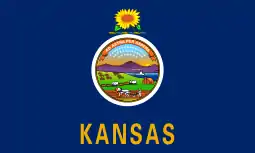K-187 (Kansas highway)
K-187 is a 7.999-mile-long (12.873 km) state highway in the U.S. state of Kansas. Located entirely within Nemaha County, K-187 runs from K-9 in Centralia north to U.S. Route 36 (US-36) west of Seneca. It is a paved, two-lane road for its entire length.
| ||||
|---|---|---|---|---|

K-187 highlighted in red | ||||
| Route information | ||||
| Maintained by KDOT | ||||
| Length | 7.999 mi[1] (12.873 km) | |||
| Existed | March 9, 1955[2]–present | |||
| Major junctions | ||||
| South end | ||||
| North end | ||||
| Location | ||||
| Counties | Nemaha | |||
| Highway system | ||||
| ||||
Before state highways were numbered in Kansas there were auto trails. K-187's southern terminus closely follows the former Kansas White Way and the northern terminus closely follows the former Pikes Peak Ocean to Ocean Highway. K-187 was established as a state highway on March 9, 1955, and its alignment has not changed since.[2]
Route description
K-187 begins at K-9, also known as John Riggins Avenue, in Centralia and begins traveling north along 2nd Street. The highway exits the city after about .4 miles (0.64 km) and continues north through rural farmlands.[3] After roughly 2.8 miles (4.5 km) it crosses Weyer Creek, a tributary of North Fork Black Vermillion River. K-187 continues north approximately 1.2 miles (1.9 km) then intersects Stringtown Road. The highway continues north through more rural farmlands and after another roughly 3.2 miles (5.1 km) has an at-grade crossing with a Union Pacific Railroad track. From here it continues north roughly .8 miles (1.3 km) and ends at US-36 west of Seneca.[4]
The Kansas Department of Transportation (KDOT) tracks the traffic levels on its highways, and in 2019, they determined that on average the traffic ranged from 915 vehicles per day north of Centralia to just over 1000 vehicles per day in Centralia.[5] The entire route is paved with partial design bituminous pavement.[1][6] K-187 is not included in the National Highway System.[7] The National Highway System is a system of highways important to the nation's defense, economy, and mobility. K-187 does connect to the National Highway System at its junction with US-36.[8]
History
Prior to the formation of the Kansas state highway system, there were auto trails, which were an informal network of marked routes that existed in the United States and Canada in the early part of the 20th century. K-187's southern terminus closely follows the former Kansas White Way and the northern terminus closely follows the former Pikes Peak Ocean to Ocean Highway.[9]
K-187 was assigned by the State Highway Commission of Kansas, now known as KDOT, on March 9, 1955, and its alignment has not changed since.[2][4] K-187's southern terminus, K-9, originally went south from Centralia then east to K-63 in Corning. Then in a different March 9, 1955 resolution, K-9 was approved to be realigned to go directly east to K-63 from Centralia.[10]
Major intersections
The entire route is in Nemaha County.
| Location | mi[1] | km | Destinations | Notes | |
|---|---|---|---|---|---|
| Centralia | 0.000 | 0.000 | Southern terminus | ||
| Richmond–Marion township line | 7.999 | 12.873 | Northern terminus | ||
| 1.000 mi = 1.609 km; 1.000 km = 0.621 mi | |||||
See also
 Kansas portal
Kansas portal U.S. Roads portal
U.S. Roads portal
References
- Staff (2016). "Pavement Management Information System". Topeka: Kansas Department of Transportation. Retrieved April 16, 2017.
- State Highway Commission of Kansas (March 9, 1955). "Resolution for Addition to State Highway System Nemaha County". Topeka: State Highway Commission of Kansas. Retrieved July 30, 2019.
- Bureau of Transportation Planning (July 2004). City of Centralia (PDF) (Map). KDOT City Maps. Topeka, KS: Kansas Department of Transportation. Retrieved August 18, 2020.
- Bureau of Transportation Planning (January 2010). Nemaha County (PDF) (Map). [c. 1: 211,200]. General Highway Map. Topeka: Kansas Department of Transportation. Retrieved October 27, 2020.
- Bureau of Transportation Planning (2020). Traffic Flow Map Kansas State Highway System (PDF) (Map). [c. 1:1,584,000]. Topeka: Kansas Department of Transportation. Retrieved October 31, 2020.
- Staff (2012-05-09). "Pavement Management Information System Glossary". Topeka: Kansas Department of Transportation. Retrieved October 31, 2020.
- Federal Highway Administration (May 8, 2019). National Highway System: Kansas (PDF) (Map). [c. 1:3,900,000]. Washington, DC: Federal Highway Administration. Retrieved October 31, 2020.
- Natzke, Stefan; Neathery, Mike; Adderly, Kevin (September 26, 2012). "What is the National Highway System?". National Highway System. Washington, DC: Federal Highway Administration. Retrieved July 29, 2019.
- Rand McNally and Company (1924). "Kansas" (Map). AutoTrails Map, Southern Nebraska, Eastern Colorado, Kansas, Northeastern New Mexico, Northern Oklahoma. 1:1,600,000. Chicago: Rand McNally and Company. OCLC 2078375. Retrieved June 15, 2020 – via Rumsey Collection.
- State Highway Commission of Kansas (March 9, 1955). "Resolution for Relocation and Redesignation of Road in Nemaha County". Topeka: State Highway Commission of Kansas. Retrieved September 17, 2019.
